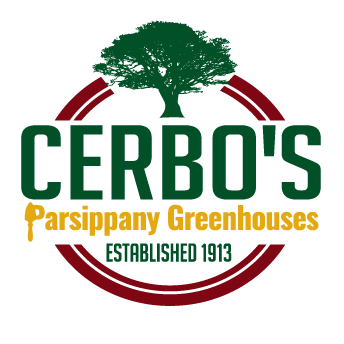Showing 1–16 of 76 results
-
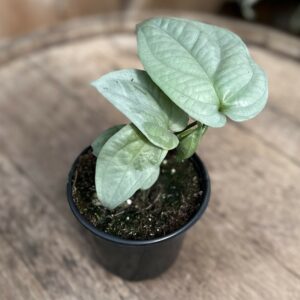
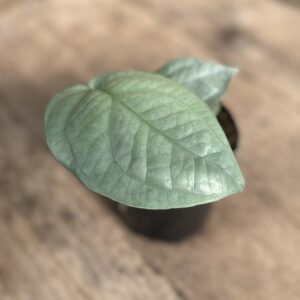
$29.99
Amydrium medium ‘Silver’ Care
Light: Provide bright, indirect light for your Amydrium Medium Silver. It appreciates bright, filtered sunlight but should be protected from harsh direct sun exposure.
Temperature: Maintain a warm and consistent temperature between 65-80°F (18-27°C).
Humidity: Amydrium Medium Silver benefits from higher humidity levels.
Watering: Water the plant when the top inch of the soil feels dry to the touch. Water thoroughly, allowing excess water to drain from the pot.
Soil: Use a well-draining potting mix rich in organic matter. A mixture that includes peat moss, perlite, and orchid bark works well to provide good drainage.
Fertilization: Feed your Amydrium Medium Silver with a balanced liquid fertilizer every 4-6 weeks during the growing season (spring and summer).
-

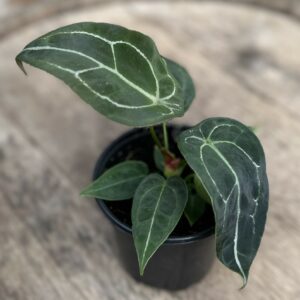
$34.99
Anthurium forgetii Care
Light: Provide bright, indirect light for your Anthurium forgetii.
Temperature: Maintain a warm and consistent temperature range between 65-80°F (18-27°C).
Humidity: Anthurium forgetii enjoys higher humidity levels. To provide adequate moisture, mist the plant’s foliage regularly, use a humidity tray, or place the pot on a bed of pebbles and water. Proper humidity is crucial for healthy growth and blooming.
Watering: Water your Anthurium forgetii when the top inch of the soil feels dry to the touch.
Soil: Use a well-draining potting mix that contains organic matter and offers good aeration. A mix consisting of peat moss, perlite, and orchid bark is suitable for Anthurium forgetii.
Fertilization: Feed your plant with a balanced liquid fertilizer every 4-6 weeks during the growing season (spring and summer).
-
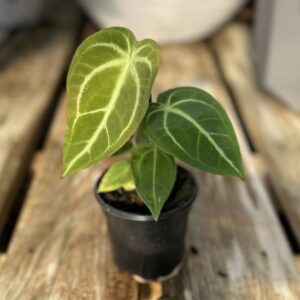
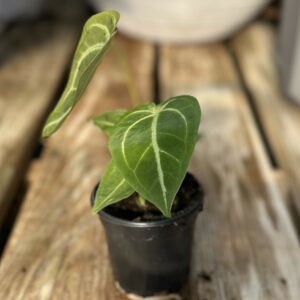
$34.99
Anthurium magnificum Care
Light: Provide bright, indirect light for your Anthurium magnificum. It appreciates filtered sunlight or dappled shade. Avoid exposing it to direct sunlight, as this can scorch the leaves.
Watering: Keep the soil consistently moist but not waterlogged. Water when the top inch of the soil feels slightly dry. Anthuriums do not like to dry out completely, so maintaining a consistent level of moisture is essential.
Humidity: Anthurium magnificum thrives in high humidity. Regular misting or placing the plant on a tray filled with water and pebbles can help create a more humid environment. Grouping plants together can also increase humidity levels.
Soil: Plant your Anthurium magnificum in a well-draining, peat-based potting mix. A mix formulated for orchids or aroids works well. Ensure the pot has drainage holes to prevent waterlogging.
Temperature: Maintain a warm environment for your Anthurium magnificum. It prefers temperatures between 65°F to 80°F (18°C to 27°C). Protect it from drafts and sudden temperature fluctuations.
Fertilization: Feed your Anthurium magnificum with a balanced liquid fertilizer every 4-6 weeks during the growing season (spring and summer). Reduce or eliminate fertilization in the fall and winter when the plant is not actively growing.
-
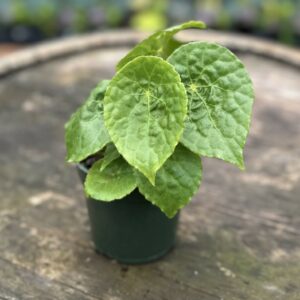
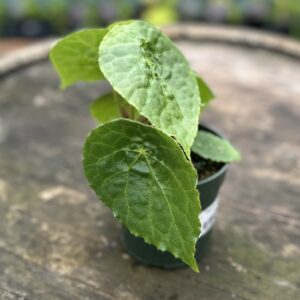
$12.99
Begonia natunaensis Care
Light: Bright, indirect light; avoid direct sunlight.
Watering: Keep soil consistently moist but not waterlogged.
Humidity: Prefers higher humidity; mist occasionally.
Temperature: Maintain temperatures between 65-75°F (18-24°C).
Soil: Use well-draining, peat-based potting mix.
Fertilization: Feed monthly with a balanced liquid fertilizer during the growing season.
-

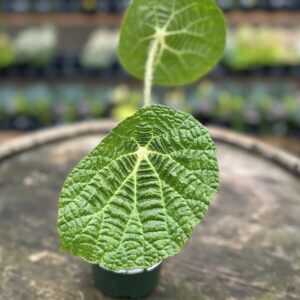
$19.99
Begonia paulensis Care
Light: Filtered to medium indirect light; avoid direct sunlight.
Watering: Keep soil consistently moist but not waterlogged.
Humidity: High humidity; mist regularly or use a humidifier.
Temperature: Maintain temperatures between 65-75°F (18-24°C).
Soil: Use well-draining, peat-based potting mix.
Fertilization: Feed monthly with a balanced liquid fertilizer during the growing season.
-

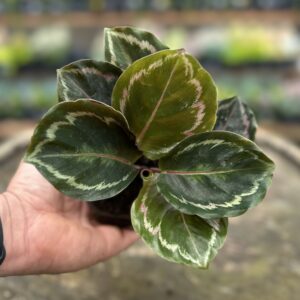
$16.99
Calathea ‘Medallion’ Care
Light: Medium to low indirect light; avoid direct sunlight.
Watering: Keep soil consistently moist but not waterlogged.
Humidity: High humidity; mist regularly or use a humidifier.
Temperature: Maintain temperatures between 65-80°F (18-27°C).
Soil: Use well-draining, peat-based potting mix.
Fertilization: Feed monthly with a balanced liquid fertilizer during the growing season.
-
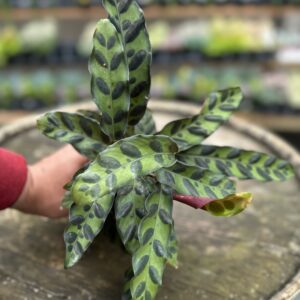
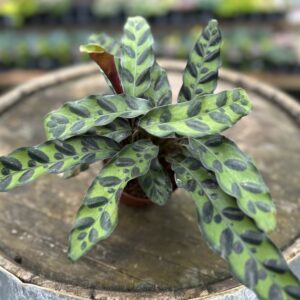
$17.99
Calathea lancifolia ‘Rattlesnake’ Care
Light: Medium to low indirect light; avoid direct sunlight.
Watering: Keep soil consistently moist but not waterlogged.
Humidity: High humidity; mist regularly or use a humidifier.
Temperature: Maintain temperatures between 65-80°F (18-27°C).
Soil: Use well-draining, peat-based potting mix.
Fertilization: Feed monthly with a balanced liquid fertilizer during the growing season
-

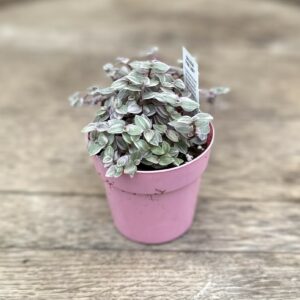
$9.99
Callisia ‘Pink Lady’ Care
Light: Indirect to Bright Light: Place your ‘Pink Lady’ where it can receive bright, indirect sunlight.
Watering: Moderate Moisture: Water your ‘Pink Lady’ when the top inch (2.5 cm) of the soil feels dry to the touch.
Temperature: Moderate Temperatures: Maintain an indoor temperature between 65°F to 75°F (18°C to 24°C).
Humidity: Average Humidity: While it can tolerate average indoor humidity levels, ‘Pink Lady’ appreciates slightly higher humidity.
Fertilizing: Occasional Feeding: Feed your ‘Pink Lady’ with a balanced, water-soluble houseplant fertilizer diluted to half-strength every 6-8 weeks during the growing season (spring and summer).
-
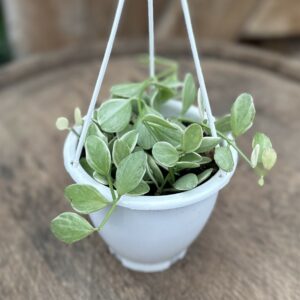

$29.99
Dischidia Care
Light: Provide bright, indirect light for your Dischidia. It appreciates plenty of natural light but should be protected from direct sunlight, which can scorch its delicate leaves. A north or east-facing window with filtered sunlight is ideal.
Temperature: Maintain a warm and consistent temperature. Dischidia prefers temperatures between 65°F to 75°F (18°C to 24°C). Avoid exposing it to cold drafts or sudden temperature fluctuations.
Pot and Soil: Plant your Dischidia in a well-draining orchid or epiphytic mix. These plants are epiphytic, meaning they naturally grow on other surfaces like tree branches, so a lightweight, well-draining mix is essential. Ensure the pot has good drainage.
Watering: Keep the soil slightly moist but not waterlogged. Water sparingly, but thoroughly, allowing the top inch of the potting mix to dry out between waterings. Watering from the bottom of the pot can be beneficial. Avoid getting water on the leaves, as they are susceptible to rot when wet.
Humidity: Dischidia enjoys higher humidity levels, so misting the plant regularly or using a humidity tray can help. Grouping it with other plants can also create a microclimate with increased humidity.
Fertilization: Feed your Dischidia sparingly. Use a balanced, water-soluble fertilizer diluted to half the recommended strength. Fertilize every 2-3 months during the growing season (spring and summer) and reduce or stop fertilization during the dormant period (fall and winter).
-
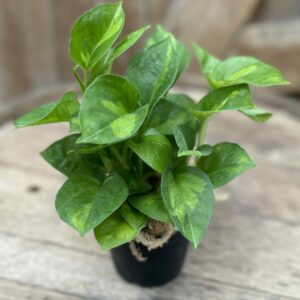
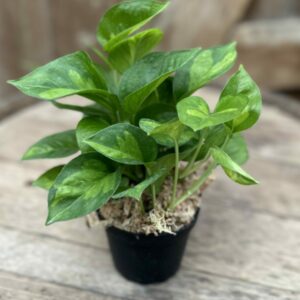
$22.99
Epipremnum ‘Global Green’ Care
Light: Pothos ‘Global Green’ can tolerate a range of light conditions, but it thrives in medium to bright, indirect light.
Temperature: Maintain a warm environment for your Pothos. It prefers temperatures between 65°F to 85°F (18°C to 29°C).
Watering: Allow the top inch of the soil to dry out before watering. It’s better to slightly underwater than overwater.
Soil: Use a well-draining, all-purpose potting mix.
Humidity: Pothos can tolerate average indoor humidity, but higher humidity levels can promote healthier growth.
Fertilization: Feed your Pothos ‘Global Green’ every 4-6 weeks during the growing season (spring through early fall) with a balanced liquid fertilizer diluted to half strength.
-

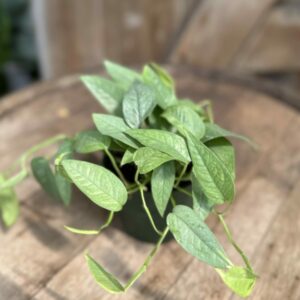
$12.99
Epipremnum pinnatum ‘Cebu Blue’ Care
Light: Provide bright, indirect light for your Cebu Blue Pothos. It can tolerate lower light conditions, but its growth and color will be best in medium to bright indirect light.
Temperature: Maintain a temperature range between 60°F to 80°F (15°C to 27°C).
Humidity: While Cebu Blue Pothos can tolerate average indoor humidity, it appreciates slightly higher humidity levels. Misting the leaves occasionally or using a humidity tray can help create a more suitable environment.
Watering: Allow the top inch (2.5 cm) of the soil to dry out between waterings.
Soil: Use a well-draining potting mix appropriate for indoor plants. Adding perlite or sand can enhance drainage.
Fertilizing: Feed your Cebu Blue Pothos with a balanced liquid fertilizer diluted to half strength every 4-6 weeks during the growing season (spring and summer).
-

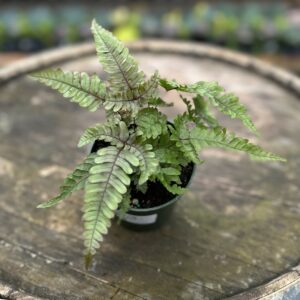
$12.99
Fern Tricolor Care
Light: Indirect light to partial shade; avoid direct sunlight.
Watering: Keep soil consistently moist; avoid waterlogging.
Humidity: High humidity; mist regularly or use a humidifier.
Temperature: Maintain temperatures between 60-75°F (15-24°C).
Soil: Use well-draining, peat-based potting mix.
Fertilization: Feed monthly with a balanced liquid fertilizer during the growing season.
-

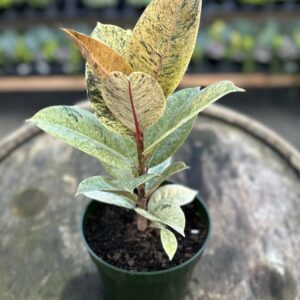
$29.99
Ficus elastica ‘Shivereana’ Care
Light: Bright, indirect light. Tolerates lower light conditions.
Temperature and Humidity: Between 65°F to 75°F (18°C to 24°C). Can tolerate average indoor humidity, but appreciates higher humidity levels.
Watering: Allow the top inch (2.5 cm) of the soil to dry out between waterings. Water thoroughly when you do water, ensuring that excess water drains from the pot.
Soil: Well-draining potting mix appropriate for indoor plants.
Fertilizing: Feed with a balanced liquid fertilizer diluted to half strength every 4-6 weeks during the growing season (spring and summer).
-

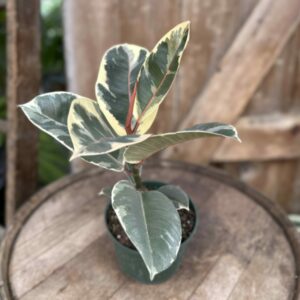
$19.99
Ficus Elastica ‘Tineke’ Care
Light: Provide bright, indirect light for your Ficus elastica ‘Tineke.’ It tolerates lower light conditions, but its variegation will be more vibrant and prominent in medium to bright indirect light.
Temperature: Maintain a temperature range between 65°F to 75°F (18°C to 24°C).
Humidity: While Ficus elastica ‘Tineke’ can tolerate average indoor humidity, it appreciates slightly higher humidity levels.
Watering: Allow the top inch (2.5 cm) of the soil to dry out between waterings.
Soil: Use a well-draining potting mix appropriate for indoor plants. Adding perlite or sand can enhance drainage.
Fertilizing: Feed your Ficus elastica ‘Tineke’ with a balanced liquid fertilizer diluted to half strength every 4-6 weeks during the growing season (spring and summer).
-
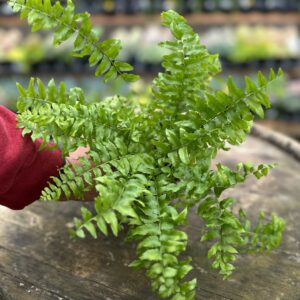

$12.99
Fishtail Fern Care
Light: Indirect to low light; avoid direct sunlight.
Watering: Keep soil consistently moist; do not allow to dry out completely.
Humidity: High humidity; mist regularly or use a humidifier.
Temperature: Maintain temperatures between 60-75°F (15-24°C).
Soil: Use well-draining, peat-based potting mix.
Fertilization: Feed monthly with a balanced liquid fertilizer during the growing season
-

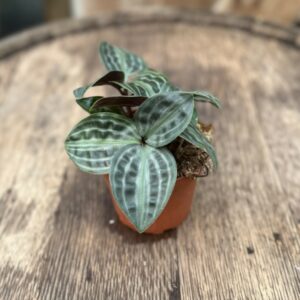
$22.99
Geogenanthus poeppigii Care
Light: Geogenanthus poeppigii prefers bright, indirect light.
Temperature: Maintain a temperature range between 60°F to 75°F (15°C to 24°C).
Humidity: Geogenanthus poeppigii appreciates higher humidity levels. You can increase humidity by misting the leaves, using a humidity tray, or placing a humidifier nearby.
Watering: Keep the soil consistently moist but not waterlogged. Water when the top inch (2.5 cm) of the soil feels dry.
Soil: Use a well-draining potting mix. Adding perlite or sand can help improve drainage.
Fertilizing: Feed your Geogenanthus poeppigii with a balanced liquid fertilizer diluted to half strength every 4-6 weeks during the growing season (spring and summer).
